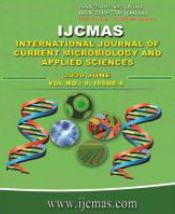


 National Academy of Agricultural Sciences (NAAS)
National Academy of Agricultural Sciences (NAAS)

|
PRINT ISSN : 2319-7692
Online ISSN : 2319-7706 Issues : 12 per year Publisher : Excellent Publishers Email : editorijcmas@gmail.com / submit@ijcmas.com Editor-in-chief: Dr.M.Prakash Index Copernicus ICV 2018: 95.39 NAAS RATING 2020: 5.38 |
The present investigation on Optimization of must and fermentation conditions for production of jack fruit (Artocarpus heterophllyus L.) wine was carried out in the department of Post-Harvest Technology , Kittur Rani Channamma College of Horticulture (University of Horticultural Sciences , Bagalkot), Arabhavi, during the year 2010-2011. It consisting of different treatments viz T1- Must with 24 oBrix TSS + 3.2 pH+1:2 dilution, T2- Must with 24oBrix TSS+ 3.3 pH+1:2 dilution, T3- Must with 24oBrix TSS + 3.4 pH+1:2 dilution, T4- Must with 24oBrix TSS + 3.5 pH+1:2 dilution, T5- Must with 24oBrix TSS + 3.2 pH+1:2.5 dilution, T6- Must with 24oBrix TSS + 3.3 pH+1:2.5 dilution, T7- Must with 24oBrix TSS + 3.4 pH+1:2.5 dilution and T8- Must with 24oBrix TSS + 3.5 pH+1:2.5 dilution. The experiment was laid out in a completely randomized design with three replications. The main objective was to standardize the optimum level of dilution and pH in the jack fruit must. Various biochemical and organoleptic quality of wine recorded at regular interval during the storage of wine. The TSS, total sugars, reducing and non-reducing sugar content in all the treatments decreased following fermentation.. The least TSS and sugars were observed in the wine made from must with 1:2.5 dilution + 3.4 pH (T7) in the fresh wine as well in the aged wine under cold condition and in must with 1:2.5 dilution + 3.5 pH (T8) under ambient condition The left over sugars in the fresh wine had a range from 8.86 (T8) to 10.79 (T4) per cent respectively. Tannins per cent were showed non-significant difference and decreasing trend can be seemed over period of aging, T8 (must with 1:2.5 dilution + 3.5 pH) observe the highest per cent of tannins throughout the investigation. The clarity of wine as revealed by maximum transmission (1.56 and 1.67) was noticed in T8 and T3 aged under cold and ambient condition.
 |
 |
 |
 |
 |